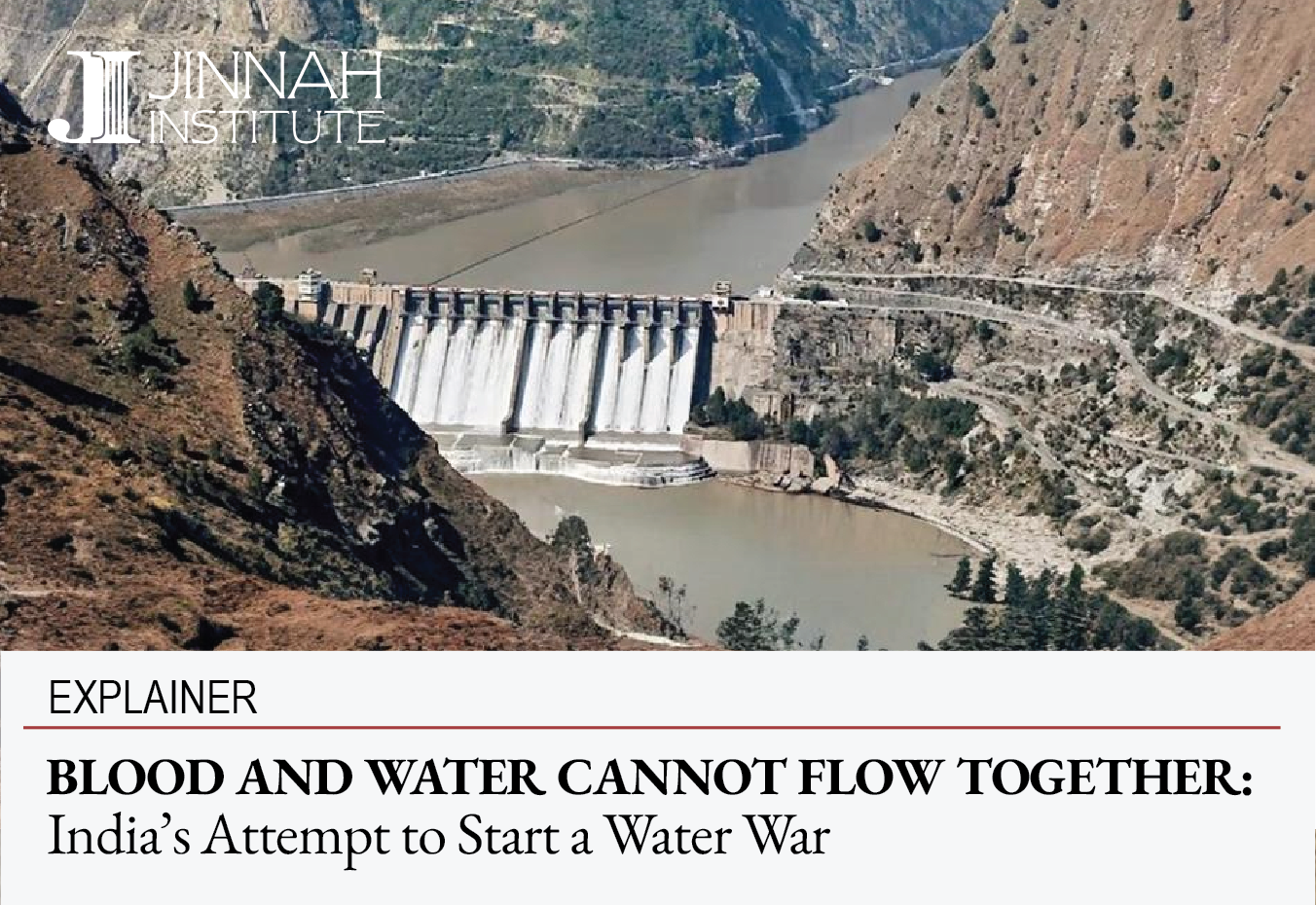Explainer
Blood and Water Cannot Flow Together: India’s Attempt to Start a Water War
Date: April 30, 2025
Can India cut off Pakistan’s water?
India cannot cut off water to Pakistan without enormous engineering and environmental adjustments on its side, and potentially high political costs. The three western rivers: Indus, Jhelum, and Chenab, account for more than 80 percent (117 billion cubic metres) of the Indus Basin’s total flows. If India attempted to store or divert that volume, it would need to build storage equivalent to 30 Tehri Dams every single year. Given the time and space required, this is neither logistically nor financially feasible. Each Tehri-scale dam takes nearly a decade to construct and would require extremely large land masses to build at that scale.
Diversion is also unrealistic. Redirecting even one of these rivers would require constructing channels or tunnels over unstable terrain. The costs would run into lakhs of crores, with a construction timeline stretching into decades. Moreover, such projects risk flooding upstream Indian territory and destroying local ecosystems. India’s current upstream infrastructure, including dams like Kishanganga and Baglihar are run-of-the-river systems, have limited live storage, and are built for power generation.
This is assuming we have comprehensive information about dams and run of the river storages on the Indian side. India has neither shared full information on this score, nor has it ever informed regarding the scale of flood diversion channels and structures. Some experts hold that decreasing water flows over the last two decades are attributable to India withholding water through undeclared storage, such as several dozen newly expanded wetlands in the IIOKJ region that curtail flows from Chenab and Jhelum rivers.
So, such a move can’t harm Pakistan at all?
India can very well manipulate seasonal releases or withhold flood data, which will disrupt Pakistan’s crop cycles, increase costs and disturb crop yields downstream, especially during months when water flows are limited. Pakistan’s irrigation system depends on predictable flows, especially during the dry season from October to March. Even small changes in the timing of water releases—rather than volume—can disrupt sowing calendars, reduce crop yields, and strain inter-provincial water-sharing arrangements. For example, delays during the wheat planting season or an unexpected dip in flow in January could severely impact output. Hydropower production at dams like Tarbela and Mangla would also suffer, particularly during low-flow periods.
The most immediate risk is the introduction of uncertainty. Pakistan’s agricultural and energy systems have been built around predictability that has held for decades. The erosion of treaty protections could undermine those assumptions. Even without immediate physical damage, the pressure from unpredictability can stress water governance and food security in Pakistan.
Experts differ on when such a disruption can impact Pakistan. There can be short term episodes, as seen on 26th April 2025 with the release of large water quantities from India, that saw the Jhelum surge from 18 cumecs (cubic metre per second) to 26.4 cumecs within hours near Muzaffarabad. Medium term disruptions can impact entire crop yields within two years, and the long term can see a lot more infrastructure buildup along the Western rivers.
“The two parties to the IWT can not unilaterally suspend the Treaty: there is no provision for suspension. But, India has already made the Treaty dysfunctional by its decision of August 2024 to postpone the mandated annual meetings of the Permanent Indus Commission. Withholding the meetings of the PIC tantamounts to suspend the IWT. In the absence of the PIC, Pakistan cannot seek or obtain information about Indian activities concerning the three western rivers allotted to Pakistan, which transit through India and IOK before flowing into Pakistan and Azad Kashmir.”
Amb. Shafqat Kakakhel
Former Envoy & Water Expert
What prevents India from doing this?
Blocking high river flows risks flooding Indian-administered Kashmir, and the terrain makes large-scale infrastructure risky. There is also surplus availability of water in that region, so India may not be able to use the water it blocks.
There is also the risk of inviting retaliatory precedent from other upper riparians, including China. Despite current posturing, India itself is a lower riparian on the Brahmaputra, which supplies nearly 30 percent of India’s freshwater and holds 44 percent of its total hydropower potential. In the aftermath of the 2017 Doklam standoff, China blocked tributaries of the Brahmaputra and withheld hydrological data in retaliation for border tensions. A year earlier, following Indian statements that “blood and water cannot flow together” after a militant attack in IIOJK, China blocked a tributary of the Yarlung Tsangpo, which became the Brahmaputra in northeast India.
There is also the legal dimension. The IWT does not contain a formal exit clause, and unilateral suspension violates international norms, especially the principle of pacta sunt servanda (agreements must be kept). India’s move to suspend the Treaty invites legal challenge, including arbitration through the Permanent Court of Arbitration, which Pakistan is considering. It also internationalises a dispute that India has historically insisted must remain bilateral.
Weaponizing water tarnishes diplomatic capital with neighbours like Nepal, Bhutan and Bangladesh closely watch India’s conduct on shared water systems. If India disregards Pakistan’s rights, it reinforces perceptions that New Delhi is willing to use water as a political tool. This could undermine ongoing and future negotiations over the transboundary Koshi, Teesta and Ganga River systems. Becoming the first state in this century to openly weaponize water will carry a major global stigma. Such a move would undercut its claims to regional leadership, open the door to international criticism, and invite comparisons India will find difficult to defend.

